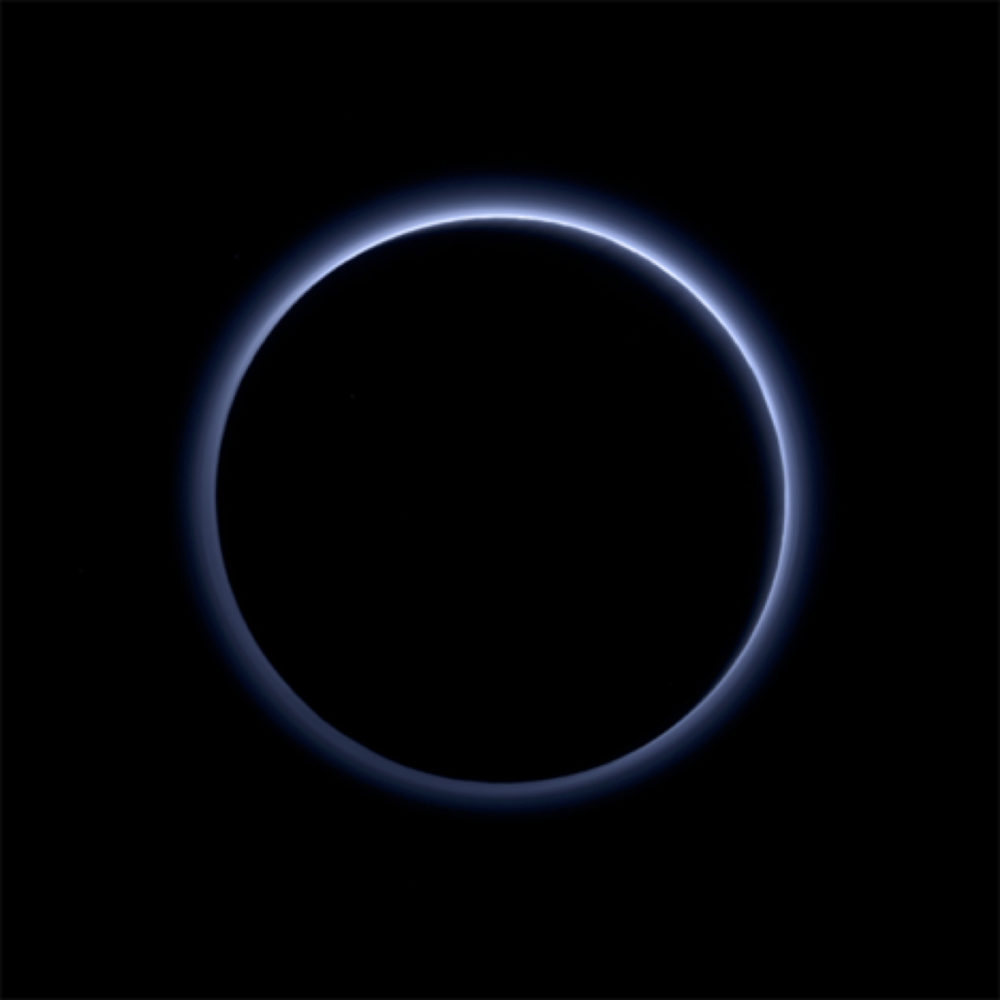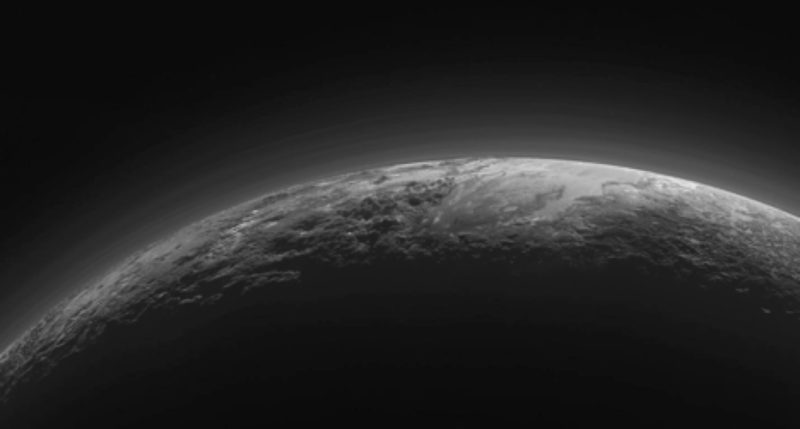
To Pluto and beyond: a journey to the outer reaches of the solar system
Pluto’s haze layer glows blue in this picture taken by the New Horizons mission imaging camera called Ralph. The high-altitude haze is thought to be similar in nature to that seen at Saturn’s moon Titan. The source of both hazes likely involves sunlight-initiated chemical reactions of nitrogen and methane, leading to relatively small, soot-like particles (called tholins) that grow as they settle toward the surface. This image was generated by software that combines information from blue, red and near-infrared images to replicate the color a human eye would perceive as closely as possible. (Image by NASA/JHUAPL/SwRI)
On Jan. 19, 2006, a powerful Atlas V rocket thundered off from Florida carrying NASA’s New Horizons spacecraft. It got relatively little public attention. But its acceleration was singularly brutal: the destination of its payload was Pluto, over 3 billion miles away. The nuclear-powered New Horizons craft, carrying a mere 1,000 pounds of instruments, went on to set NASA interplanetary speed records the whole way.
After nearly a decade, New Horizons finally reached Pluto in July. This time, the spacecraft made front-page news around the world. The dwarf planet and its big moon Charon revealed themselves as stunning geologic wonderlands.
Speaking in Cambridge, Mass. Oct. 11 as part of CASW’s New Horizons in Science briefing at the ScienceWriters 2015 conference at the Massachusetts Institute of Technology, Principal Investigator Alan Stern reminded his audience of the New Horizons mission’s historic place in planetary exploration. All traditional major members of the solar system have now had a close, robotic human look-see. To get a close look at the last, the dwarf planet Pluto, at least five missions were proposed, but none got funded. What finally raised Pluto to the top of the priority list and earned funding for New Horizons, Stern told the science writers, was the discovery of a gigantic swarm of small, icy bodies known as the Kuiper Belt.
Previously, scientists thought that there were only two major types of planets—the rocky terrestrials (Mercury, Venus, Earth and Mars) and the gas giants (Jupiter, Saturn, Uranus and Neptune). Pluto was a runt, a lone misfit, just a fuzzy dot in telescope images.
The 1992 discovery of the Kuiper Belt—the largest structure in our solar system—demonstrated that Pluto belongs to a third class of orbiting bodies in the outer solar system. “That’s a huge discovery, and it was completely unexpected,” Stern said in an interview after his talk. The Kuiper Belt’s members together have more surface area than all of the major planets combined. Pluto is not only the largest of these objects, but it may also be the most complex. This realization, said Stern, convinced the National Academy of Sciences, after 40 years of planetary exploration, to urge NASA to send a mission to Pluto.
Hitting a golf ball into a soup can—a continent away
The mission took over 14 years to get funded, another four years to build, and then nearly 10 more years to cover the 3.2 billion miles to Pluto. By all accounts, it is an extraordinary engineering accomplishment. The journey would have taken four years longer if the spacecraft had not received its speed boost from Jupiter’s gravity by flying through a “window” 100 kilometers wide as it accelerated, or fell, toward Jupiter and then, as planned, narrowly missed striking the planet while departing on a precise trajectory to its main target. Stern compared the feat to hitting a golf ball in Los Angeles that plops into a soup can in New York.
Initial results from New Horizons’ exploration of the Pluto system were published in the Oct. 16 issue of the journal Science.
Stern noted that the New Horizons mission has answered one of the most basic questions about Pluto—its size, debated ever since Pluto’s discovery in 1930. Mission scientists have found Pluto to be 1,475 miles (2,370 kilometers) in diameter, somewhat larger than earlier estimates. This spacecraft’s flyby at an altitude of 7,800 miles at closest approach has provided spectacular high-resolution images of Pluto’s surface and its atmosphere. Images showing sunlight skimming through Pluto’s atmosphere at sunrise and sunset reveal that the atmosphere has a dozen or more layers.
The discovery of ice fields and mountains the size of the Rockies on the surface of Pluto are redefining what we knew about the geology of these distant worlds. Scientists had known from Pluto’s light spectrum that it has a coating of frozen nitrogen. However, Stern said, frozen nitrogen is too weak to support much weight even in Pluto’s gravity. Discovery of mountains 11,000 feet tall suggest sturdier water ice under the frozen nitrogen.
A heart the size of Texas

A big icy plain, dubbed Pluto’s “heart” as soon as its shape came into focus during the probe’s approach, is the size of Texas. The scarcity of craters on much of the surface suggests a very new surface and implies, Stern said, that even in the deep freeze of its orbit there has been geologically recent action in Pluto’s interior. Other surface features indicate wind streaks and glacial flow made up most likely of nitrogen, carbon monoxide and methane ices. The face of Pluto’s largest moon, Charon, also indicates a surprisingly complex and violent history that is largely distinct from Pluto’s countenance. Such findings have sent geologists into a frenzy of speculation.
“It turned out fantastically and better than I expected,” Stern said. “It was just like uber-spectacular. People loved it, and the science has been phenomenal, and everything worked on the spacecraft during the flyby, and it’s just been a dream come true.”
When asked if he wished he had done anything differently, he said, “Yeah, I’d fly two spacecraft, to get the other side of Pluto.”
The spacecraft’s closest approach to Pluto happened on July 14. However, as of October, only about 15 percent of the onboard instruments’ data has been streamed back to Earth. That job will continue until late 2016, and then the spacecraft will head off to visit an object in the Kuiper Belt identified as 2014 MU69. That flyby is scheduled for January 1, 2019.New Horizons will continue to inform and inspire for years to come.